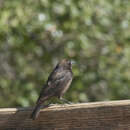en
names in breadcrumbs


Perception Channels: visual ; tactile ; acoustic ; chemical
The cowbird is common. It does, however, pose a threat to the populations of other birds, such as the Kirtland's Warbler, Black-capped Vireo, and Least Bell's Vireo, whose small populations are frequently parasitized by the Brown-headed Cowbird. This has led to programs that involve trapping of the cowbirds at specific breeding areas where other species are threatened.
US Migratory Bird Act: protected
US Federal List: no special status
CITES: no special status
State of Michigan List: no special status
IUCN Red List of Threatened Species: least concern
Fragmentation of forest habitats in North America has resulted in a great increase in the edge habitats favored by cowbirds, and a reduction (and in many places an elimination) of forest-interior habitats that cowbirds do not penetrate. As a result, a number of species of forest birds are now subject to increasing parasitism by cowbirds. Cowbird parasitism may be one cause in the general decrease in numbers of songbirds in North America.
The cowbird eats many insects which are pests to humans.
Cowbirds often feed on the ground, away from vegetation. Their main food items are seeds and arthropods. They sometimes hawk, looking for slow flying insects. In a quantitative anaylsis of the cowbird diet, it was found that nearly 75% of the diet was 'weed' seed, with most of the remaining 25% made up of grasshoppers and beetles.
Cowbirds breed from SE Alaska, through lower Canada, through the entire continental U.S. to central Mexico. They winter throughout this range, and also in southern Mexico and the tip of Florida.
Biogeographic Regions: nearctic (Native )
Cowbirds prefer habitats with low or scattered trees among grassland vegetation, such as woodland edges, brushy thickets, prairies, fields, pastures, orchards, and residential areas. Fragmentation of forests has greatly increased the Brown-headed Cowbirds favorite habitat.
Terrestrial Biomes: forest
Average lifespan
Status: wild: 202 months.
The cowbird is a small blackbird with a short conical bill and long, pointed wings. Males appear black with a unique brown head and neck. Females are either dullish gray or brown throughout. The bill is a dull grey, while the eyes are black.
Range mass: 40 to 50 g.
Other Physical Features: endothermic ; homoiothermic; bilateral symmetry
Average basal metabolic rate: 0.6315 W.
The Brown-headed Cowbird is a brood parasite; the female cowbird selects a host nest of another species of bird to lay her eggs in. She wanders about, parasitizing many nests and laying up to 40 eggs per season. The young are then cared for by the host. 144 different host species have been documented to rear cowbird young, so the incubation and parental care of cowbirds varies greatly depending on the nest in which they are deposited. During the various care processes for the cowbirds, however, they are always fed more often than the young of the host species. The smallest recorded host of cowbird young is the 10 g creeper, while the largest host is the 150 g meadowlark.
Key Reproductive Features: iteroparous ; gonochoric/gonochoristic/dioecious (sexes separate); sexual ; oviparous
Average time to hatching: 11 days.
Average age at sexual or reproductive maturity (male)
Sex: male: 365 days.
Average age at sexual or reproductive maturity (female)
Sex: female: 365 days.